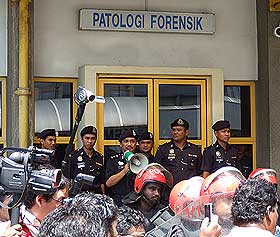COMMENT | The Shipman Inquiry – launched by the British government to investigate the murders of about 250 patients at the hands of serial killer Dr Harold Shipman – uncovered among coroners and pathologists an “attitude that it would be to everyone’s satisfaction if a cause of death can be found that will enable the coroner to certify the cause of death without further delay, cost or inconvenience”.
The report from the inquiry also noted that “it is easy to see how this attitude can become entrenched”. To counter this, it recommended that pathologists should be instructed and trained to “think dirty”.
“Thinking dirty” does not entail coroners and pathologists approaching each death with the expectation that there will be something amiss; rather, it means they should keep in mind the worst possibilities, and actively look out for signs of non-natural death.
Do pathologists in Malaysia need to be instructed to do the same? Certainly, the extraordinary post-mortem findings of a number of local custodial death cases inevitably lead one to call into question either their competence, integrity, or both.
Take the case of P Karuna Nithi. The 42-year-old died in custody at the Tampin police station on June 1, 2013.
The pathologist, Dr Sharifah Safoorah Syed Alwee, from the Tuanku Ja’afar Hospital in Seremban, concluded that the deceased had died of fatty liver change despite noting the 49 injuries on the corpse and his mild liver disease.

Somewhat fortuitously, during a 2015 inquest into the death of Karuna Nithi (photo), the coroner rejected the post-mortem findings and held the cause of death to be from acts and omissions committed by fellow inmates and policemen.
The case did not end there. The public prosecutor subsequently requested that the case be reopened, and introduced purported “new evidence” of a report by a committee of six pathologists commissioned by the Ministry of Health to “review” Sharifah Safoorah’s post-mortem report.
The committee concluded that the cause of Karuna Nithi’s death was “multiple blunt force trauma in a man with a moderate fatty change of liver”.
And in an extraordinary move, they also attempted to explain that Sharifah Safoorah’s post-mortem finding was the result of her being “falsely informed” of certain facts, such as being given CCTV evidence of Karuna Nithi’s abuse in the lock-up.
In April 2016, the coroner maintained his initial verdict. Undeterred, the public prosecutor applied for a revision of the whole proceeding, which turned out to be unsuccessful, after the High Court upheld the verdict in October 2017.
More than 1,000 dead, in just seven years
The frequency of custodial death cases should come as a shock to Malaysians.
According to police statistics, the number of detainees who died in their custody from 2000 to 2014 was 255.
The number of deaths in prisons and immigration detention centres are much higher. In prisons, 1,654 died between 2010 and February 2017. In immigration detention centres, 82 deaths were recorded in 2015, and 35 the next year.
Of these numbers, how many deaths have our pathologists attributed to as “natural causes/diseases,” so that the detention authorities can claim no responsibility?
Among the most common causes of death stated by detention authorities are asthma, jaundice, ulcers, blood conditions, tuberculosis, as well as diseases of the intestines, liver, lungs and throat. All of these are generally preventable or treatable if given proper and timely medical attention.

Can the medico-legal death investigative procedure be so simplistic? If it is a fact that a detainee has died from a medical condition, or that an inordinate number of persons are dying in a given detention facility, is it not important for the pathologist to address the issue and other significant factors contributing or precipitating the cause of death?
It is high time the post-death forensic investigative procedure in custodial death cases is reformed, so that hospitals and pathologists are able to perform their roles competently and independently.
And in order to do so, there must be a process of check and balance, where post-mortem reports are audited and held to account, without the need for a second post-mortem or inquest process.
There should be great soul-searching among medical authorities as to why in cases like those of A Kugan, S Balamurugan and Karuna Nithi, pathologists have been compelled to make inexplicable findings that have had the effect of exonerating custodial authorities, when the medical evidence and other circumstances show otherwise.
This is an urgent call for reform, and for our medical authorities not to forsake their sworn duty to do no harm and start taking custodial deaths more seriously.
They have an indispensable role to play in bringing the truth to light – or stifling it – if they choose to downplay or turn a blind eye to signs of injuries, neglect and other suspicious circumstances in their medico-legal death investigations.
As the Court of Appeal said in Kugan’s civil case, “…to state the obvious, there has been a custodial death, and that should have rung ‘alarm bells from the word go’.”
Yesterday: Custodial death autopsies: A process in dire need of reform
ERIC PAULSEN is the executive director of Lawyers for Liberty. LFL lawyers have represented the families of A Kugan, Karuna Nithi and S Balamurugan in civil claims and inquiries into their deaths.
The views expressed here are those of the author/contributor and do not necessarily represent the views of Malaysiakini.

